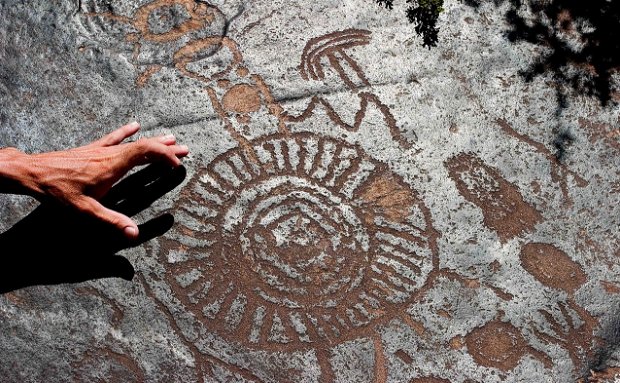The rock art & rock gongs of Nelspoort

Rock gongs and ancient etchings: the remarkable art of Nelspoort
The Karoo is a place that reveals its ancient mysteries only slowly. But how often has it revealed one of its greatest secrets in such a heart-warming way?
There’s not much to do in Nelspoort, a tiny railway town a little more than 86 km south of Victoria West, and 52 km north-east of Beaufort West - so how did Laurence Rathenham, head teacher at the local Restvale Primary School, keep the street kids who’d found a safe home in the school hostel busy during the holidays?
He took them out into the veld to adventure and explore.
And there, in the summer of 2001, they discovered something wonderful: a whole world of engravings etched onto the rocks of the area.
One of the kids found an antelope, then another found another little buck… and then someone found an elephant, and then someone found something else…
Karoo Landscape
Anyone who’s ever driven through this part of the Karoo will know how flat and arid the land can be - but Nelspoort is characterised by a ravine (poort) of dolerite koppies on either side of the Sout River.
Rising to between 1,000 and 1,400 metres above sea level, these koppies, the various biomes that exist in and around them, their elevation above the surrounding landscape, and the presence of water, all proved attractive for the Bushmen or /Xam (the First Nations of hunter-gatherers) who inhabited most of the interior of South Africa for tens of thousands of years, as well as to the Khoe - the herders who entered the area around 2,000 years ago - and the white settlers who arrived in the modern era.
Thus, when the academics came to study the findings, they were able to identify at least eleven distinct sites over a vast area of around 150 square kilometres (the Klipkraal complex) - with rock engravings and other artefacts from all three traditions: Bushman, Khoe, and Historic Period.
Sound of the Karoo
But it isn’t only etchings: stone tools from the Early and Middle Stone Ages, ostrich shell shards, ostrich shell beads, grindstones, and many other traces of the lives of those early ancestors are still there at long-abandoned camp sites and middens throughout the district.
And here and there - and particularly at Site 1, or Klipkraal 1, just 80 metres off the tar road - numerous lithophones, too.
Lithophones - or gong rocks - are dolerite (‘ironstone’) boulders that possess natural resonating properties: either because they lie in just the right way on top of other rocks, or because they’re shot through with natural cracks that cause the sound to resonate when they’re hit by stones or by hand.
This produces a sweet, ringing sound that travels out across the landscape - and, as later research suggests, that would have been a vital component of the rock art (engravings, and, perhaps, paintings) that surround them.
“In the same way music and architecture were vital to Christian cathedrals, so the eerie, elemental sound of the gong rocks would have travelled over the landscape, imbuing the rock engraving site with a particular level of extra-ordinariness.” (Sven Ouzman)
Geometry, therianthropes & extinct buffalo
The subject matter of the engravings at the 11 sites at Nelspoort includes geometric sunbursts, circles, and grids - which would have been made by the Khoe people - as well as drawings of animals such as antelope, ostrich, eland, and elephant, and also half-human, half-animal ‘therianthropes’ that would have been made by the /Xam.
Three particularly interesting features of the art at Klipplaat include
- a series of 13 feline pugmarks (spoor) in one trackline;
- an equid (or zebra-like animal) with stripes only on its head and hindquarters - meaning this may be a drawing of an extinct quagga; and
- a large (99 cm-long) bovine that may represent the extinct giant buffalo, Pelorovis antiquus. (P. antiquus - a third bigger than the modern African buffalo, weighing 2,000 kg, and with a hornspan of three metres at least - is thought to have become extinct between 2,000 and 12,000 years ago. Fossilised specimens are as rare as this engraving, with examples having been found only at Florisbad near Bloemfontein, and at Langebaan in the Western Cape).
As far as the Historical Period is concerned, engravings at Klipplaat include a human-like ‘Viking’ figure, as well as the names of people who lived here in the colonial era, and of soldiers who passed through during the South African War (1899-1902)
Visiting Nelspoort
Despite their importance to the history of our country, the rock art and rock gongs of Nelspoort haven’t been developed as a tourist attraction - but Restvale Primary School's head, Laurence Rathenham, remains the custodian of this unique collection.
Contact him on 023 416 1648 or 073 603 2013 or email [email protected] to arrange a guided visit.
Getting to Nelspoort from Victoria West
Travel south on the N12; keep right at the Three Sisters Junction; you'll now be driving on the N1. Travel a further 17 km, and turn off to Nelspoort on your left. Travel a further 8km.
Allow about 50 minutes travelling time from Caro’s Karoo.
Etiquette
- Please only ever visit sensitive archaeological sites in the company of trained guides
- Take photos for sure, but don’t ever touch the etchings on the rocks - the natural oils in modern human skin are harmful to ancient art
- Remove nothing (no samples, no stone tools, no plants), and leave only footprints
- Never scratch the rocks (even the ones without engravings!)
- Never hit the gong rocks: you’ll damage the hammer marks, which contain ancient and important information about the ages of the gongs.
Header image: Rock Art at Nelspoort - author, South African Tourism. CC BY 2.0 via Wikimedia Commons
Article by Martin Hatchuel for Caro's Karoo. December, 2021



Share This Post